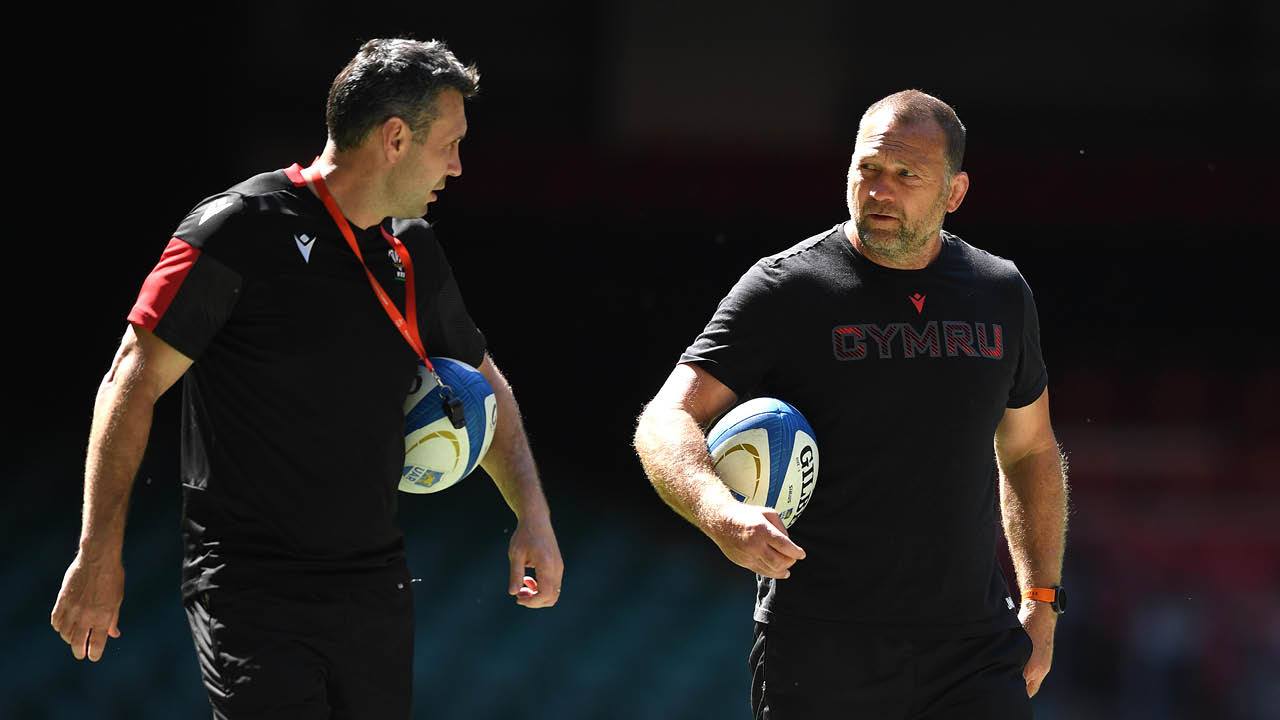As hooker for Bath and Cardiff, Jonathan Humphreys earned 35 caps for his country and now he’s back in the international set-up as forwards coach. He spoke to Jon Newcombe for rhino.direct

Jonathan Humphreys’ scrum life. Jonathan Humphreys enjoyed a successful playing career at hooker with Wales, Cardiff and Bath before turning to coaching with the Ospreys in 2005.
The 35-times capped player spent eight years at the Liberty Stadium, in which time the Ospreys won three Celtic League titles and an EDF Energy Cup.
Then the 52-year-old headed north to Scotland, initially to work under Vern Cotter with the Scotland national team, spending four years in the role spanning Rugby World Cup 2015, before linking up with Dave Rennie as forwards coachat Glasgow.
After Rugby World Cup 2019, Jonathan returned home as part of Wayne Pivac’s new-look coaching team, again as forwards coach.
How did you end up in the front row?
“When I was at school (Cornelly in Bridgend), I was a centre who wouldn’t pass the ball so my schoolteacher, a guy called Chris Coles, I’ll never forget, said I was best suited, he thought, to playing in the front row. Much to my mother’s disgust, where I ended up, and I loved it.”
What did you like about playing there?
“Prop and hooker are the only positions on the field where you can guarantee you are going to have physical contact, because there has got to be a scrum at some point. I just think it is the mentality of it, it is a very confrontational position to be in, and I enjoyed that part of it.”
Is there one specific scrum that stands out for you?
“When I was playing for Bath, Leicester had a lot of success with a scrum where Julian White would angle in and they’d all just shove right across. Our forwards coach, Mike Foley, developed a system where the hooker would go at him and we’d try and get all the force against him. He’d been given man of the match the week before because they’d absolutely destroyed Newcastle’s scrum. But we went there and were dominant on the day, and we very nearly won. Harry Ellis went around me to score in the corner in the last minute to give them the draw. My excuse is that Mearsy’ (Lee Mears) pulled his hamstring in the warm-up and because he couldn’t come on, I had to play the whole game.
From a coaching perspective, Leicester feature again. It was a winner-takes-all game in Europe, the one where the Ospreys had 16 players on the field at one point. Leicester were a very, very good scrummaging team and there was a scrum on the 10-metre line where we pushed them back, on their own ball, and won a penalty. The front row that day was Paul James, Richard Hibbard and Adam Jones. It was the day they really emerged and showed everyone what they were capable of as a front row.”

How much have scrum machines changed much in your time?
“In the old days, they were very complex things and had a big wheel on the back but they are much more streamlined nowadays. We use the sledge scrum machine with three pads on it. It is a very uncomplicated machinery. When the ‘touch, pause, engage’ (cadence) finished, there was a lot more weight being transferred through the front rows, making it very difficult to get an engagement on scrum machines. Now, we use it more for channelling of the ball and timing of pushing and those sorts of things.”
Was rugby coaching something you always wanted to do?
“The plan was for me to coach at Bath once I finished playing. I was going to be like an assistant to the forwards coach,Foles. My last-ever game was against Leeds, and we lost, and the owner at the time, Andrew Brownsword, phoned me up after the game saying they didn’t want another forwards coach, they wanted another backs coach. So I ended up going to the Ospreys instead.
While I was playing, I never really thought about getting into coaching or becoming a rugby coach, I just sort of fell into it. I was part of the first era of professional rugby players who spent the majority of their career as a professional so the transition out of that wasn’t tried and tested.”
What’s the biggest lesson that you’ve had to learn along the way
“Knowing what you want and what your principles are and understanding how best to present them are the most important things as a rugby coach. Scott Johnson was an excellent mentor for me in this respect.”
What gives you the most satisfaction as a rugby coach?
“When players start talking your language to each other when going over something technical, as if it’s them who have come up with the phraseology in the first place, that’s the most satisfying thing for me.”
If players did a parody of you speaking, what buzzword would they use
“‘The space is in the air’! I used that in lineout rugby drills a lot when I started out at the Ospreys. Some of the Ospreys boys, who are involved now with Wales, still quote it back to me after all these years.”
Is scrummaging under-valued?
“The scrum is definitely a unique facet of rugby union. The value of it is massive. If you can dominate your opponents at the scrum and at the maul it gives you a huge psychological advantage. The trouble is referees do not ref it the same way they say they’d like it to be done before a game. For example, they say, ‘you must scrummage square’, and all of this sort of stuff but, when it comes down to it, this doesn’t happen. That’s when you get a lot of frustrating re-sets. For me, they need to ref to the laws. It is very easy to get a tight-head to hammer across the scrum, that takes no technical input at all. The hardest thing to coach is to get a player to shove straight.”
What components make a good scrum?
“It is such a technical area of the game but it is also very simplistic in terms of the biomechanics of how it should work. The essential component is that you need five people behind the front row who have something to push on. Because of the height of the front row and because of the shape of the front row, that can be a very difficult thing to do. It is like a circuit breaker, if one person in the front row is pushing in a different direction, it doesn’t work.
What’s your ‘go-to’ rugby drill in forwards coaching sessions?
“We have a drill where the tight-head prop is on his own with a lock and a flanker behind him against a hooker, loose-head, a lock and a flanker, so basically a 4 v 3. The tight-head has to have his hand attached to me, not the opposition front row. The only way it works for him is if he stays straight and square. If he angles in, he is gone. I have seen the 3 beat the 4 but it is rare.”
Biggest coaching disappointment?
“Not winning Europe with the Ospreys. We had the team capable of doing it but didn’t get past the quarter-finals.”
Humphreys’ dream pack
“I’ve decided to go for a pack based entirely on players I’ve coached. I had too many players to choose from otherwise! As you can see, there is a big Ospreys contingent.”
1) Paul James
An incredibly strong scrummaging prop, physically and mentally. Came from a tough background like my hooker, Richard Hibbard, and was one of those people you could rely on in every game.
2) Richard Hibbard
I like really big hookers and he was a big, physical, confrontational character. Even before they picked him for Wales, I thought he was the best hooker in Europe.
3) Adam Jones
When Adam first started for Wales, he’d be coming off after 30 minutes. What he went on to achieve was through a lot of hard work. For a good few years he was the best scrummaging tight-head prop in the world and the best at staying square.
4) Alun Wyn Jones
What hasn’t been said about the guy! I was lucky enough to have coached him from 20 years of age, just when he was breaking into the Ospreys team. Within a few months, he was playing for Wales.
5) Jonny Gray
He’s an incredible character. When I went to Scotland, he was just starting out in test rugby and was very raw. But he worked tremendously hard to get to where he has in the game. In one game for Glasgow, I think he made something like 42 tackles. Unless you coach him or play with him, you don’t appreciate how good he is.
6) Jerry Collins
When he turned up at the Ospreys from Toulon, he couldn’t run, he couldn’t straighten his knee, and he was hobbling around the place. So when Scott picked him for a game at Leicester, everyone was like ‘are you mad?’ But, oh my god when you put him on the field, he was catching wingers. An incredible competitor and one of the most generous people I’ve ever met. I was gutted when I heard about his death.
7) Justin Tipuric
It is hard to pick between Marty Holah and Tips because they spent so much time together doing extra drills after training, to help each other improve. But I’m going to have to go with Tips.
8) Filo Tiatia
A man amongst men is Filo. Such a great person off the field but he was absolutely ruthless on it. I loved that about him. Dynamic but with the power to go with that.

